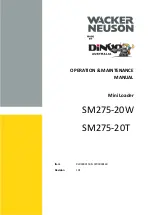
III-84
•
Have you had other service problems in the last few months?
Answer:
No.
•
(If the answer was yes, you should ask—When? Where?
What
was
fixed or replaced?).
•
Finally, ask the operator if he or she has a wiring diagram for the
system.
Now let
·
s look at the information you have gathered from the operator and what you
know from experience. He believes the problem is that the AC system quits cooling
after it has been on for a while! You know that the AC system has not been maintained
since the rig was purchased a year ago. Because of that, there could be several causes
for the problem (lack of cooling) and there may be other potential problems about to
develop.
It is possible that some refrigerant has leaked. Moisture and other contamination
may be inside the system. You have been told there are no heater problems, but that
doesn
·
t mean there are none that might affect AC system operation. The AC system
has quit cooling several times in the last few days. The problem may have become
more severe than when it quit cooling the first time.
If enough refrigerant or oil has leaked out, a low pressure cutout switch may have
cut the circuit to the clutch, protecting the compressor. Because the system has not
been maintained in a year, there may be other components that should be serviced. You
could fix the probable causes, and the system might work and then break down again
as the rig drives out of your place. From your knowledge and what the operator has just
told you, you know this may not be a quick fix problem.
It
·
s up to you to describe the service situation to the operator. Tell him you need to
do a complete system maintenance inspection to find and correct the problem or other
potential problems. He can give you the go ahead for full service and repair now, wait
till you have inspected the system to determine cause and cost, or delay repair until he
has some down time available.
Normally when the operator can tell you what the problem is, you would first oper-
ate the system to verify the problem. In this situation your troubleshooting (your own
knowledge added to what the operator told you), indicates the next step. You need to
do a complete maintenance inspection instead! Proceed as described in
Chapter 7
.
Correct any obvious problems and check carefully for leaks. Leak testing should be
visual, by feel and with a leak detector. Next, do your performance test with the engine
running and the AC system on.
Note:
Don
·
t forget to check the heater system too! If the water valve
is not closed, then hot engine coolant flowing through the heater
core would warm the air at the same time the evaporator was
trying to cool it. The result would be the appearance of an AC
problem.
A Troubleshooting Example
Summary of Contents for TL150
Page 1: ...TL150 Track Loader BOOK No CT7E901 WORKSHOP MANUAL Serial No 21500004...
Page 4: ...0 4...
Page 5: ...I 1 I GENERAL...
Page 18: ...I 14 GENERAL...
Page 19: ...II 1 II SPECIFICATIONS...
Page 44: ...III 1 III MACHINE CONFIGURATION...
Page 94: ...III 51 MACHINE CONFIGURATION ELECTRICAL SYSTEM ELECTRICAL SYSTEM ELECTRICAL WIRING DIAGRAM...
Page 122: ...III 79...
Page 146: ...MACHINE CONFIGURATION III 103...
Page 147: ...IV 1 IV HYDRAULIC UNITS...
Page 152: ...IV 6 HYDRAULIC UNITS HST PUMP 1 Plug 2 Plug 3 Plug 4 Screw 5 Seal Nut 6 Plug Pump Assembly 4 4...
Page 189: ...IV 43 HYDRAULIC UNITS GEAR PUMP INSPECTION AND ADJUSTMENT IV 36 38 TROUBLESHOOTING IV 39...
Page 230: ...IV 84 HYDRAULIC UNITS PILOT VALVE INSPECTION AND ADJUSTMENT IV 79 TROUBLESHOOTING IV 80...
Page 261: ...IV 115 HYDRAULIC UNITS TRAVEL MOTOR DISASSEMBLY AND ASSEMBLY Special tools...
Page 263: ...IV 117 HYDRAULIC UNITS TRAVEL MOTOR...
Page 282: ...IV 136 HYDRAULIC UNITS TRAVEL MOTOR...
Page 283: ...V 1 V TROUBLESHOOTING...

































